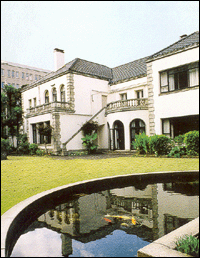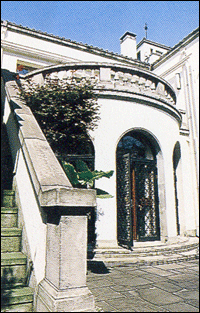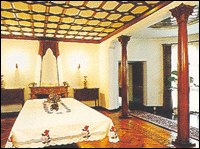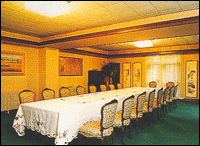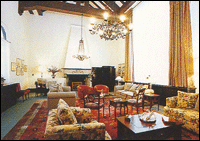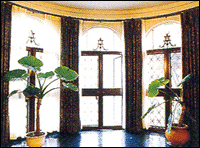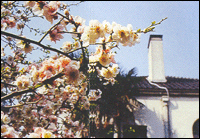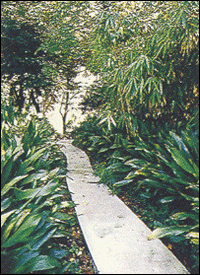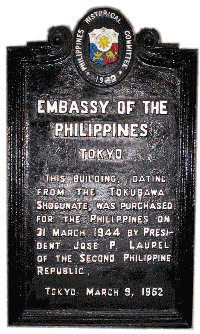|
About the Official Residence of the Philippine Ambassador Straddled into a 4,500 square meter piece of prime land, the residence was commissioned in 1934. It sports an Iberian architectural design as evident in the intricate details found in the various rooms of the residence. Senior Yasuda commissioned the construction of the residence using special tiles especially from his hometown, Toyama Prefecture. The ceilings, columns, the fireplace, and floors were all built using Japanese materials. The original design of the residence, especially the atelier (which now serves as the Music Room) took into consideration, the artistic and musical inclinations of Senior Yasuda’s son. In fact, the music room was constructed for home concerts for many Yasuda gatherings. It also bears noting that the famous Ms. Yoko Ono, a granddaughter of the Senior Yasuda, enjoyed many lovely hanami (sakura blossoms) viewing during spring in the residence. Upon entering the residence, one could not help but notice immediately the black ornate grill-gate. The driveway has Castilian features, with a rotunda of greenery planted to spruce up’ the place. The sturdy and shiny blue-gray roof tiles of the building is Castilian in design. This contrasts with the subdued ecru beige exterior paint of the facade.
Introduction The Philippine Ambassador to Japan maintains his official residence at 1-1-1 Fujimi, which is located in one of the quiet hilltop neighborhoods in Chiyoda-ku. Its Japanese address literally translates into “a hill from which one can get a good perspective of Mt. Fuji.” Indeed, long-time residents attest that on a clear day they used to enjoy the splendor of Mt. Fuji from the hill.
History Pre-1944 Based on official records obtained by the Embassy staff, the residence used to be occupied by Baron Zenjiro Yasuda and his family. Baron Yasuda was the founder of the pre-war Yasuda Zaibatsu, which was in the financial business, and the Fuji group of companIes. Previous Occupants President Jose P. Laurel bought the property in 1944. Since then, the place has been the official residence of the Philippine Ambassadors to Japan and their respective families |
|
| Function Rooms
As one steps into the anteroom, a guestbook and an ornate mirror welcomes the guest. In the foyer, a portrait of the country’s foremost national hero, Dr. Jose P. Rizal hangs prominently and a bust of President Jose P. Laurel sits in the middle of the ante part of the room. An antique Seiko grandfather clock sits quietly near the staircase and a lovely and sparkling. |
| A. Diplomatic (Blue) Room
The Diplomatic Room is a lovely specimen of beautiful Iberian architecture. It is bedecked with several oil paintings of old Manila and some Spanish tiled houses of a bygone era. The Yasuda emblem attached on the casing of the fireplace is still preserved. B. Dining Rooms (i) Small Dining Room (Rose Room) A small dining room (or the Rose Room) capable of sitting 12 persons is located between the foyer and the main dining room. It has a lovely wooden parquet-tiled floor. It also sports a lovely marble encased fireplace. Two Iberian columns supporting a tinted canopy lend character to the grand view of the garden. Three Yasuda emblems sit atop each of the three adjacent grilled doors in the dining room foyer that lead to the garden. (ii) Main Dining Room Adjoining the small dining room is the Main Dining Room. The sturdy dining table, as well as the buffet side tables in the room, are made from the finest Philippine mahogany wood. The long dining table is capable of sitting 20 persons. A lovely antique china cabinet sports Iberian carvings. The two small functional chandeliers provide soft lighting to the room. The Main Dining Room used to be the family tatami room of the Yasuda family. C. Music (Piano) Room Aside from its excellent acoustic system, the high-ceiling Music Room has a beautiful choir balcony. A Yamaha grand piano occupies one prominent comer of the room. A small room farther behind the Music Room was said to have been a hidden office of Senior Yasuda. |
|
| Private Quarters (2nd Floor)
A. Family Room This wide and bright room is reserved for private guests of the Ambassador. The visitor gets to see a lovely view of the garden from the balcony of the room. B. Masters’ Bedroom The Masters’ quarters has always been located at the top of the main dining room. The Masters’ quarter has its own library. C. Guest Rooms There are five other rooms on the second floor of the residence that can accommodate guests. |
|
Garden A visitor can gain access to the garden from the Diplomatic Room and from the anteroom of the Small Dining Room. From the Small Dining Room, the garden doors have their grills embellished with Karakusa-moyo Japanese patterns as well as the three Yasuda emblem carved on top of the doors. The previous occupants intended the garden to be built around Western and Japanese styles. The Japanese garden pays homage to the shrine of the Japanese fox god for business prosperity. Although the body of the shrine was taken away by the Yasuda family, one can still find the columns of the shrine, statues of two foxes, and two stone lanterns in front of the shrine foundation. The garden is interspersed with several wide-canopied trees of various varieties. The arch of the sakura trees (somei yoshino) in front of the gloriette is to be the Sakura Arch of the Philippine Embassy which gives pleasures to onlookers every year. The sakura tree at the gate (somei yoshino) was planted to serve as a symbolic act of renewed friendship between the Philippines and Japan after World War II. The ogatama (karatane ogatama), in front of the Diplomatic Room and near the apple tree, was planted in 1993. Japanese consider the tree to be sacred. It is rarely found in Japan because it is very difficult to grow or replant. Upon reaching maturity, it bears yellow small flowers which give out a banana-like scent. The camellia tree (uraku tsubaki tarokaja) located beside the rose bushes near the gazebo was planted in 1993. It is a rare camellia species, renowned for its elegant flowers and is often used for alcoves of tea ceremony houses. The vinegar tree (Essig Baum) is seen between the gazebo and garden lamp. The vinegar tree was brought in from Vienna, Austria in 1993. It is known for its beautiful branches like big ferns and big scarlet flowers shaped like big pine cones. The bonanza peach tree situated at the back of the vinegar tree, was planted in 1994. The baby magnolia tree near the pond was planted in 1995. The baby nim trees near the driveway were brought in from the Philippines in 1993. HIH Princess Hitachi planted a sakura tree (kansan no sakura) on the left side of the gazebo in 1994. Commemorative Plaque “Embassy of the Philippines, Tokyo This Building, dating from the Tokugawa Shogunate, was purchased for the Philippines on 21 March 1944 by President Jose P. Laurel of the Second Philippine Republic. Tokyo, March 9, 1952″ National Historical Committee 1952 |
|


